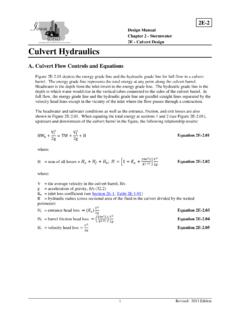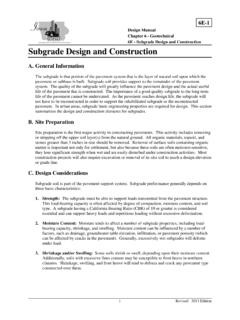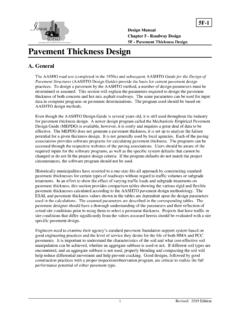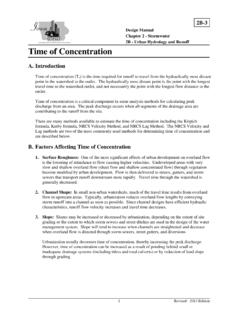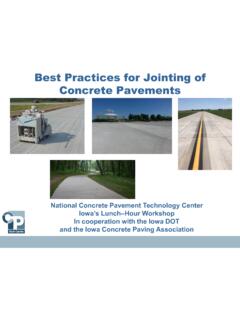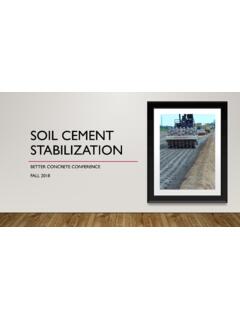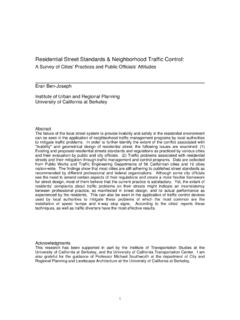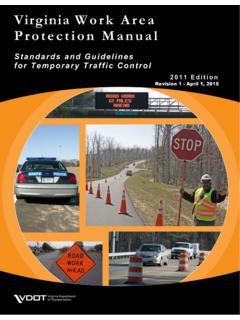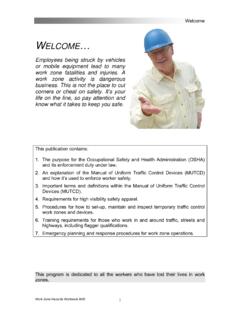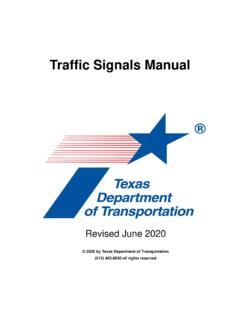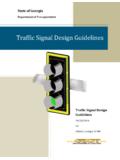Transcription of Temporary Traffic Control Handbook - Institute for …
1 Developed and Sponsored byTemporary Traffic Control HandbookInstitute for Transportation2016 EditionAuthorsPaul Wiegand, and Beth RichardsAddress2711 S Loop Drive, Suite 4700 Ames, Iowa 50010 DisclaimerNeither Iowa State University nor this document s authors, editors, designers, illustrators, distributors, or technical advisors make any representations or warranties, expressed or implied, as to the accuracy of information herein and disclaim liability for any State University does not discriminate on the basis of race, color, age, ethnicity, religion, national origin, pregnancy, sexual orientation, gender identity, genetic information, sex, marital status, disability, or status as a veteran.
2 Inquiries regarding non-discrimination policies may be directed to Office of Equal Opportunity, 3350 Beardshear Hall, Ames, Iowa 50011, Tel. 515 294-7612, email OF CONTENTSI ntroduction 2 Importance of Quality Traffic Control 2 Applicable Standards and References 3 Work Duration 4 Work Zone Temporary Traffic Control - Major Elements 5 Temporary Traffic Control devices 9 Shadow Vehicles 19 Inspection and Documentation of Temporary Traffic Control 19 Flagging in Work Zones 20 High-Visibility Safety Apparel 20 Nighttime Operations 20 Accommodation of Pedestrians and Bicyclists 21 Road and Street Closures 22 General Notes for
3 All TTC Examples 24 Legend 251. Work Beyond the Shoulder/Behind the Curb 262. Short-Duration or Mobile Operation on Shoulder 273. Work off of Pavement with Minor Encroachment onto Traveled Way 284. Lane Closure on Minor Street or Road 295. Lane Closure for Low-Volume Street or Road (Self-Regulating) 306. Work in Center of Low-Volume Street 317. Lane Closure for Short-Term or Moving Operations Using a Single Flagger 328. Lane Closure on Two-Lane Road Using Two Flaggers 339. Work in Vicinity of Highway-Rail Grade Crossing 3410.
4 Traffic Control for Outside Lane Closure of Street with Continuous Left Turn Lane 3511. Traffic Control for Closure of Continuous Left Turn Lane 3612. Street or Road Closure 3713. Short-Duration Street or Road Closure 3814. Street or Road Closure with Off-Site Detour 3915. Lane Closure at an Intersection 4016. Closure on the Far Side of an Intersection 4117. Closure within an Intersection 4218. Closure in Center of Intersection 4319. Moving Operation on Two-Lane Roads 4420. Mobile Operation on Multi-Lane Road 4521.
5 Sidewalk Detour 4622. Sidewalk Diversion 4723. Closure of Marked or Unmarked Crosswalk 482 INTRODUCTIONThis Handbook provides a broad, easy to understand reference for Temporary Traffic Control in work zones, addressing the safe and efficient accommodation of all road users: motorists, bicyclists, pedestrians, and those with special needs. When impacting a pedestrian facility, provide ten calendar days advance notification to the local jurisdiction and the National Federation of the Blind of Iowa ( ).The information presented is based on standards and guidance in the 2009 Edition of the manual on uniform Traffic Control devices (MUTCD).
6 References to the MUTCD sign designations in this Handbook are shown in parentheses, (W20-1).Not all the recommendations in this Handbook will apply to every circumstance faced by local agencies, and each unique situation may not be addressed. Modifications of the typical applications in this Handbook will be required to adapt to specific field conditions. Therefore, use engineering judgment, seeking the advice of experienced professionals and supervisors in difficult and complex interpretations. This Handbook can be used as a reference for Temporary Traffic Control in work zones on all city or county roadways. However, always check contract documents and local agency requirements for any pertinent OF QUALITY Traffic CONTROLThe value of proper Traffic Control through work zones cannot be overemphasized.
7 Three major reasons for providing quality Temporary Traffic Control can be identified:SafetyMany crashes occur each year in Iowa work zones, resulting in death and injuries to motorists and workers. Appropriate levels of Traffic Control will help lessen the occurrence of work zone use of Temporary Traffic Control , deficiency of devices , or negligence may result in legal claims against a contractor, agency, or even individual workers. Complying with accepted standards and guidance could help avoid and reduce possible legal Temporary Traffic Control in compliance with established practices is a requirement of the public trust; it s simply the right thing to do!The MUTCD is incorporated into the Code of Federal Regulations and is recognized as the national standard for Traffic Control devices on all roads open to public travel in the nation.
8 In addition, Iowa has adopted the MUTCD as the state standard (Iowa Code section and Administrative Rule 761 - Chapter 130). Local agencies are required to adhere to the MUTCD requirements in Iowa Code Section Always remember the MUTCD standard statements, The responsibility for the design, placement, operation, maintenance, and uniformity of Traffic Control devices shall rest with the public agency or the official having jurisdiction, and Temporary Traffic Control plans and devices shall be the responsibility of the authority of a public body or official having jurisdiction for guiding road users. Even though the authority for placing Temporary Traffic Control is sometimes granted to others (contractors, utilities, etc.)
9 , the responsibility for requiring properly signed work zones remains with the agency that has jurisdiction over that road or STANDARDS AND REFERENCESThe MUTCD presents minimum standards only. Iowa has adopted the MUTCD as the official standard for Traffic Control , but many applications and practices in Iowa exceed national standards. The user should check for recent revisions of t h e MUTCD and state and local policies before selecting an appropriate application from this Handbook . Ensure you have the most current version of this RequirementsOther important federal requirements and guidance are available in Federal Highway Administration s (FHWA) Standard Highway Signs manual and the National Committee on uniform Traffic Laws and Ordinances uniform Vehicle Code.
10 Worker and flagger apparel recommendations and requirements from the American National Standards Institute (ANSI) have been adopted into the MUTCD. Information about worker and flagger apparel can be found through the International Safety Equipment Association (ISEA). 4 Complying with the Proposed Accessibility Guidelines for Pedestrian Facilities in the Public Right-of-Way, also known as the Public Right-of-Way Accessibility Guidelines or PROWAG, is especially important when accommodating pedestrians. The US Access Board is an excellent source for background and supplemental accessibility information ( ). The Institute of Transportation Engineers Traffic Control devices Handbook also provides valuable supplemental RequirementsWhen working on or near any road or street right-of-way where Iowa Department of Transportation (Iowa DOT) has jurisdiction, Iowa DOT requirements take precedence over this RequirementsCities and counties may adopt ordinances and policies that apply to Temporary Traffic Control - provided these meet or exceed the standards presented in the MUTCD.
